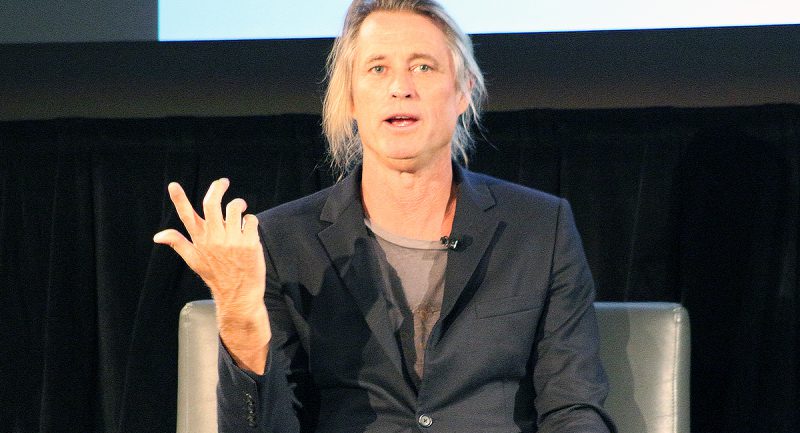There’s an uncanny way Russell James captures the delicate features of his subjects. The way he cast shadows in the most alluring way. The way his camera captures the internal dialogue of a subject.
Take Elsa Hosk’s eyes, cast in a pale grey — the color of lavender blooms when drained of hue: there’s an alarming clarity to her connection with the lens.
The contours along her lithe frame are captured by photographer Russell James in black and white. A wisp of blonde hair, now platinum (again with the hues and tones washed away), is held in place by a delicate hand.
The 29-year-old Swedish model was the first colleague he shot with for his new fine art series, Angels, launched as a Collector’s Edition in limited supply in September. James made the decision to do so due to her being candid with him for the launch of the first book.
“(Elsa) told me she was disappointed,” he wrote, regarding her absence from Angels (2014). “I was devastated!”
On that disclosure, at the bookend art exhibition, James photographed her for his next project.
There are many great anecdotes the 56-year-old Australian can share here and there about the personalities that are revealed to him by Hosk and many others. He’s active on social media, Instagram and Facebook primarily, and he’ll reveal the stories behind the shoots — intimate snapshots of the models that have become household names and, importantly, have trusted him to be the professional that he is.
“The challenges were there, like Kendall Jenner climbing a tree overlooking a public beach in little more than her thong (while we were doing everything not to be noticed), or shooting Sara Sampaio on the most breathtaking day on the edge of a horizon pool in St. Barthes and trying to avoid the paparazzi,” he admitted. “Every single shoot comes with its own unique story.”
So many individuals also come with the nuances on how to interact. In Angels (2018), James captures icons like Cindy Crawford, Elaine Irwin, and Heidi Klum.
“My entire career is based on adapting to the personalities of the people in front of my camera and never asking for it to be the other way around,” he wrote. “I am so fortunate that my career spans portraits of heads of states, indigenous culture, celebrity, and fashion.”
With Crawford, whose name is synonymous with the Supermodel era of the late 1980s and ’90s, there is a high standard of efficiency, punctuality, and professionalism.
She’s worked with Richard Avedon, Herb Ritts, and Peter Lindbergh. The old guard of photographers have produced some of the most provocative shots, and James is not different.
“I can see she respects people who are ‘ready’ and don’t waste the opportunity,” James said. “So I try my best to have things arranged so that I am precise in where and what I am asking of Cindy.”
For the vivacity of Klum, it’s based on an energy that is unique to the German model.
“Heidi and I have such a long friendship, so I try to be sure that I draw a clear line,” he said. “We have a lot of fun and banter when we work but I never allow that to mean I am not organized and ready to shoot when she is.”
Finally, Irwin posed an interesting challenge for James, who has been in the industry for quite some time.
“I hadn’t had an opportunity to shoot with her in the last 10 years, so on that shoot it was all about making an extra effort to understand how she would feel best portrayed,” he admitted. “In the end, though, it all comes back to being about the subject and not about me.
“Ego, as a photographer, is a negative distraction.”
There’s always the underlying zeitgeist of body image, and how his subjects are presented through his fine art, in the portrayal of such talent, which includes his closest colleagues, Adriana Lima, Alessandra Ambrosio, Candice Swanepoel, Lily Aldridge, and Martha Hunt.
“Body image is a very important issue,” he said, adding he talks with young women through organizations about the issue.
He’s travelled to remote communities facing challenging social economics, and has seen firsthand the impact images from social media has on them.
The results are a loss of self-esteem. But it’s not because of the excess of provocative photos, James said. It’s because there isn’t context behind the images.
With the advent of social media, especially more visually based ones like Instagram, there is no depth or context to the images of perceived beauty.
“The reason I identify with this is that with the emergence of social media we lost a way to understand what we are looking at,” he wrote. “We need to re-learn.
“An example being: previously if one went to a museum, they saw artworks purposely and openly manipulated, in many ways, to depict the impression of the artist.
“It was clear to the spectator that it was manipulated. If we opened a magazine and saw an advertisement, it was clear it was selling an aspiration, with spectacular models and gorgeous places.”
On social media, however, what is an artistic rendering is not clear. Images can be tweaked and changed through photo-editing software such as Photoshop.
“I believe we have to take far more responsibility,” James added. “An artist should still be able to be an artist but we need to find a way to be clear on what is reportage and what is art.”
As for the criticism faced, particularly since the rise of the sexual harassment-combatting #MeToo movement, James is gracious.
“I am not bulletproof and some things can hurt me,” he said. “However, I truly say ’thank you’ to my critics.
“In the end, I have to make my own judgment whether the critique is something I should react to or reject.”
Photo: Brian Baker/File
Editor’s note: This piece was originally written with the intention of publication in Sharp Magazine

